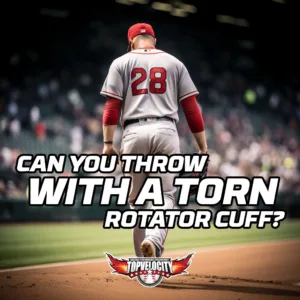 Are you searching for information on if you can Throw With a Torn Rotator Cuff? Then you must read this article!
Are you searching for information on if you can Throw With a Torn Rotator Cuff? Then you must read this article!
The rotator cuff is an important joint that consists of four muscles and their tendons. These parts work together to support and mobilize our shoulders, ensuring a full range of motion. The rotator cuff's integrity is critical for sports, particularly baseball players. It's fundamental to their ability to create the necessary power and precision in their throws.
However, when this critical group is harmed, the effects are severe. A rotator cuff tear not only causes pain and discomfort, but it also jeopardizes an athlete's career. The consequences go beyond the immediate physical discomfort, possibly jeopardizing years of preparation and success.
The Causes and Symptoms of Rotator Cuff Injuries in Athletes
Rotator cuff injuries, especially among athletes, are not uncommon. The repetitive stress and intense force exerted during sports activities, particularly in throwing sports, make athletes prone to these injuries.
Causes: Throw With a Torn Rotator Cuff
According to a study by Wilk et al., (2011), the repetitive overhead throwing motion in baseball players can lead to a series of adaptive changes and acute trauma. This continuous overhead motion can result in microtrauma, leading to rotator cuff injuries if not managed properly.
Another study by Shanley, E., & Rauh, M. J. (2011) highlighted that young throwers who experience fatigue are 36 times more likely to suffer from shoulder injuries. This suggests that excessive throwing without adequate rest can be a significant factor leading to rotator cuff issues.
Symptoms: Throw With a Torn Rotator Cuff
Symptoms of rotator cuff injuries vary, but according to Escamilla et al., (2009), they can include:
- Pain and tenderness in the shoulder, especially when lifting the arm or lying on it.
- A sensation of weakness or stiffness in the shoulder.
- Audible snaps or clicks when moving the shoulder.
- Difficulty in achieving full range of motion.
In a more recent study by Clarsen, B., Bahr, R., & Andersson, S. H. (2014), athletes with rotator cuff injuries also reported experiencing pain that worsened at night, making sleeping difficult, and a decreased ability to perform activities that require reaching overhead.
The Diagnosis Process for Rotator Cuff Tears
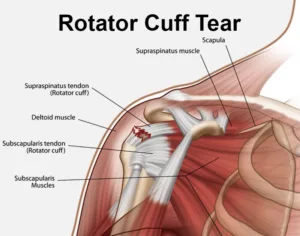 Recognizing and accurately diagnosing a rotator cuff tear is pivotal for ensuring the right treatment and subsequent recovery. The following is a step-by-step guide based on empirical research to guide individuals suspecting a rotator cuff injury.
Recognizing and accurately diagnosing a rotator cuff tear is pivotal for ensuring the right treatment and subsequent recovery. The following is a step-by-step guide based on empirical research to guide individuals suspecting a rotator cuff injury.
- Clinical Evaluation: The initial stage involves a detailed clinical examination. A study by Sein et al., (2010) suggests that a thorough patient history and physical examination are indispensable. Questions regarding the onset of pain, the nature of the injury, and any exacerbating or relieving factors are typically posed.
- Range-of-Motion (ROM) Testing: Hermans et al., (2013) highlight the importance of assessing the range of motion. During this test, the patient will be asked to move their arm in various directions. Limited or painful motion can be indicative of a tear.
- Strength Testing: Weakness in the arm may signify a rotator cuff injury. This is assessed by resisting the patient's arm movements in certain directions (Jobe's test and drop-arm test) or using the armcare.com dynamometer.
- Imaging: Magnetic Resonance Imaging (MRI) is considered the gold standard for diagnosing rotator cuff tears (Sher et al., 1995). It provides a detailed view of the soft tissues, including the muscles and tendons.
- Ultrasound: According to Roy et al., (2015), ultrasonography is a reliable and cost-effective method to detect rotator cuff tears, especially when MRI is not feasible.
If you experience symptoms indicative of a rotator cuff tear, seek medical attention promptly. Early diagnosis can lead to better treatment outcomes and quicker recovery.
Can You Throw With a Torn Rotator Cuff?
The decision of whether or not to throw with a torn rotator cuff is complicated and is heavily influenced by the severity of the injury. The rotator cuff, which is made up of four muscles and tendons, is in charge of supporting and mobilizing the shoulder. A slight tear may enable some mobility, but it will almost certainly be accompanied by pain and decreased strength.
A torn rotator cuff can severely impair performance in athletes, particularly baseball players who rely heavily on their shoulders for pitching. While throwing with a slight rip is physically doable, doing so risks more injury and a longer recovery. Throwing puts a lot of strain on the shoulder, and without the full support of a healthy rotator cuff, the risk of issues increases.
Throwing would be exceedingly painful and possibly impossible in situations of a complete or major tear. Immediate medical care is required, as well as various therapies such as physical therapy or surgery. Rather than risking further injury by throwing, the major focus should be on healing and ensuring the long-term health of the shoulder.
Treatment and Rehabilitation for Rotator Cuff Tears
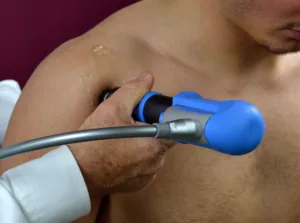 Treatment and rehabilitation for rotator cuff injuries are of paramount importance for complete recovery and return to optimal function. The approach varies based on the severity and type of the tear.
Treatment and rehabilitation for rotator cuff injuries are of paramount importance for complete recovery and return to optimal function. The approach varies based on the severity and type of the tear.
Conservative Treatments:
According to a study by Kuhn, J.E. (2009), the majority of rotator cuff tears can benefit from non-surgical treatments. Common conservative approaches include:
- Physical Therapy: Specialized exercises aim to restore flexibility and strength to the shoulder, reducing pain and improving function (Düzgün, İ., Baltacı, G., & Atay, O. A., 2017).
Post-surgical Rehabilitation:
Rehabilitation after surgery is vital. A systematic review by Warby et al., (2018) emphasizes the role of graded strength training and movement exercises in accelerating recovery post-surgery.
Extracorporeal Shockwave Therapy (ESWT):
Extracorporeal Shockwave Therapy, is a non-invasive medical treatment that uses shockwaves to stimulate healing in injured tissues. At TopVelocity, we can certainly provide you with information about how pulse wave therapy can be beneficial for athletes dealing with joint injuries.
Pulse wave therapy can be particularly useful for athlete injuries in the following ways:
- Promoting Healing: ESWT stimulates blood flow and accelerates the body's natural healing processes. This can help athletes recover from injuries more quickly.
- Pain Relief: It can provide pain relief by reducing inflammation and increasing the production of natural pain-relieving substances in the body.
- Tendon Injuries: ESWT has been used to treat various sports-related injuries, such as Achilles tendonitis, plantar fasciitis, and tennis elbow. It can help break down scar tissue and stimulate the repair of damaged tendons.
- Reducing Surgery Risk: In some cases, pulse wave therapy can be used as an alternative to surgery, which can be particularly appealing to athletes who want to avoid lengthy recovery periods.
- Improving Mobility: Athletes often need to regain full mobility after an injury. ESWT can help by reducing stiffness and promoting tissue regeneration.
- Minimal Downtime: One of the advantages of ESWT is that it typically involves minimal downtime, allowing athletes to return to training and competition sooner.
At TopVelocity, our team of medical professionals is equipped with the latest evidence-based knowledge and techniques to offer these treatments. With a commitment to helping athletes and individuals regain peak performance, we ensure a tailored approach to treatment and rehabilitation for each patient.
How Brent Pourciau Overcame a Rotator Cuff Tear
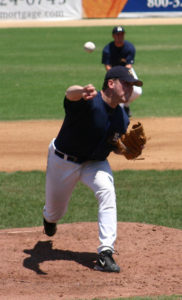 Brent Pourciau's story is one of resilience, determination, and a burning passion for baseball. As a budding athlete during his freshman year in college, he was on the precipice of a promising career. However, fate threw a curveball, and Brent experienced a severe rotator cuff tear, a potentially career-ending injury. The weight of the diagnosis was crushing; medical experts even warned him that his days on the baseball diamond might have prematurely concluded.
Brent Pourciau's story is one of resilience, determination, and a burning passion for baseball. As a budding athlete during his freshman year in college, he was on the precipice of a promising career. However, fate threw a curveball, and Brent experienced a severe rotator cuff tear, a potentially career-ending injury. The weight of the diagnosis was crushing; medical experts even warned him that his days on the baseball diamond might have prematurely concluded.
But for Brent, giving up was never an option. The injury became both a challenge and a motivator. He delved deep into rehabilitation, adopting a rigorous regimen to restore his physical health, while mentally steeling himself for the journey ahead. His recovery wasn’t just about returning to the field; it was about returning stronger and better.
His triumphant comeback was proof of his unwavering spirit. Not only did he return to baseball, but he also pitched with even greater velocity, clocking throws in the low to mid 90s. This feat was a direct reflection of his dedication, perseverance, and the innovative techniques he adopted during his recovery.
It was this profound personal experience with injury and recovery that became the foundation of the TopVelocity programs. Brent channeled his journey and the insights he gained into developing a training system that prioritizes both performance enhancement and injury prevention. Today, TopVelocity stands as a testament to Brent’s dedication and his mission to ensure other athletes can overcome their adversities and reach their peak potential.
Preventive Measures and the Power of Specialized Training
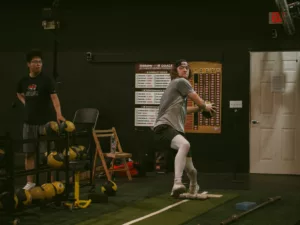 Every athlete knows that while mastering their sport is paramount, ensuring the longevity of their career by taking preventive measures is equally vital. A significant part of prevention is understanding the mechanics of one's body and adopting practices that both enhance performance and reduce injury risk.
Every athlete knows that while mastering their sport is paramount, ensuring the longevity of their career by taking preventive measures is equally vital. A significant part of prevention is understanding the mechanics of one's body and adopting practices that both enhance performance and reduce injury risk.
For baseball players, especially pitchers, the strain on the shoulder is immense. A wrong technique, overexertion, or lack of proper training can lead to severe injuries like rotator cuff tears. However, these can be avoided or their risks significantly reduced. The key lies in specialized training that focuses not just on enhancing your skills but also on strengthening your body and improving your techniques to withstand the pressures of the game.
And this is where the TopVelocity programs come into play. Built on the foundation of Brent Pourciau's own journey of recovery and excellence, these programs are designed to provide athletes with the tools they need to excel and stay injury-free.
For pitchers eager to improve their technique, increase their speed, and ensure they're pitching in a way that minimizes injury risk, the 3X Velocity Camp is a game-changer. On the other hand, position players can benefit immensely from the 2X Velocity Camp, tailored to address the unique demands and challenges they face on the field.
In essence, taking preventive measures isn't just about avoiding injuries; it's about elevating your game. So, why wait for an injury to dictate your pace? Be proactive, and give yourself the TopVelocity edge. Join us at our camps and set yourself on a path of excellence, both in performance and health.
For more exclusive content, remote coaching, and weekly video analysis checkout TopVelocity Patreon!
FAQs: Throw With a Torn Rotator Cuff
- What is the success rate of rotator cuff surgeries?
Most surgeries have a success rate of over 90%, with patients regaining significant function and experiencing reduced pain. - How long does it take to recover from a rotator cuff tear?
Recovery times vary, but with physical therapy, many can resume activities within 4-6 months. - Can you fully recover from a rotator cuff injury?
Yes, especially with early intervention, appropriate treatment, and guided rehabilitation. - How do TopVelocity programs enhance natural abilities?
By utilizing science-backed techniques tailored to individual needs, these programs optimize performance without overburdening the body. - What differentiates Brent Pourciau's approach from others?
His personal journey, combined with his expertise in kinesiology and sports science, gives a unique, holistic approach. - Why are evidence-based practices important in baseball training?
They ensure players get the best training that's both effective and safe.
References:
- Andersson, S. H., Clarsen, B., & Bahr, R. (2014). Reduced glenohumeral rotation, external rotation weakness and scapular dyskinesis are risk factors for shoulder injuries among elite male handball players: a prospective cohort study. British Journal of Sports Medicine, 48(17), 1327-1333.
- Appleyard, R., Sein, M. L., Walton, J., Linklater, J., Kirkbride, B., Kuah, D., & Murrell, G. A. (2010). Reliability of MRI assessment of supraspinatus tendinopathy. British Journal of Sports Medicine, 44(8), 548-551.
- Baltacı, G., Düzgün, İ., & Atay, O. A. (2017). Comparison of slow and accelerated rehabilitation protocol after arthroscopic rotator cuff repair: pain and functional activity. Acta Orthopaedica et Traumatologica Turcica, 51(1), 5-9.
- Bierma-Zeinstra, S. M., Hermans, J., Luime, J. J., Meuffels, D. E., Reijman, M., Simel, D. L., & Hermans, J. (2017 & 2013). Does this patient with shoulder pain have rotator cuff disease?: The Rational Clinical Examination systematic review. JAMA, 318(8), 746-756 & 310(8), 837-847.
- Desmeules, F., Roy, J. S., Braën, C., Leblond, J., Dionne, C. E., MacDermid, J. C., ... & Frémont, P. (2015). Diagnostic accuracy of ultrasonography, MRI, and MR arthrography in the characterisation of rotator cuff disorders: a meta-analysis. British Journal of Sports Medicine, 49(20), 1316-1328.
- Escamilla, R. F., Yamashiro, K., Paulos, L., & Andrews, J. R. (2009). Shoulder muscle activity and function in common shoulder rehabilitation exercises. Sports Medicine, 39(8), 663-685.
- Ford, J. J., Warby, S. A., Pizzari, T., Hahne, A. J., & Watson, L. (2018). The effect of exercise-based management for multidirectional instability of the glenohumeral joint: a systematic review. The Journal of Shoulder and Elbow Surgery, 27(1), e20-e30.
- Harker, P., Wilk, K. E., Macrina, L. C., Fleisig, G. S., Porterfield, R., Simpson, C. D., & Andrews, J. R. (2011). Correlation of glenohumeral internal rotation deficit and total rotational motion to shoulder injuries in professional baseball pitchers. The American Journal of Sports Medicine, 39(2), 329-335.
- Jung, K. H., Kim, Y. K., Won, J. S., Cho, S. H., & Cho, J. Y. (2017). Clinical and radiographic outcomes after arthroscopic repair of massive rotator cuff tears using a suture bridge technique: assessment of repair integrity on magnetic resonance imaging. The American Journal of Sports Medicine, 45(6), 1282-1290.
- Kuhn, J.E. (2009). Exercise in the treatment of rotator cuff impingement: a systematic review and a synthesized evidence-based rehabilitation protocol. Journal of Shoulder and Elbow Surgery, 18(1), 138-160.
- Murphy, B. J., Sher, J. S., Uribe, J. W., Posada, A., & Zlatkin, M. B. (1995). Abnormal findings on magnetic resonance images of asymptomatic shoulders. The Journal of Bone & Joint Surgery, 77(1), 10-15.
- Rauh, M. J., & Shanley, E. (2011). Risk factors for shoulder and elbow injuries in high school baseball pitchers: the role of preseason strength and range of motion. The American Journal of Sports Medicine, 39(9), 1995-2002.



